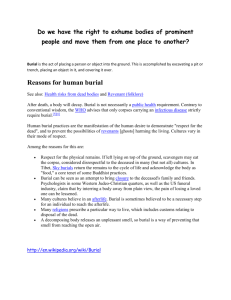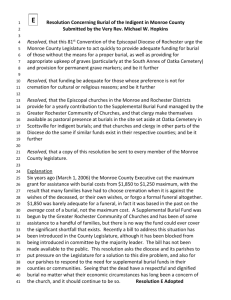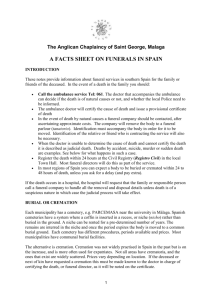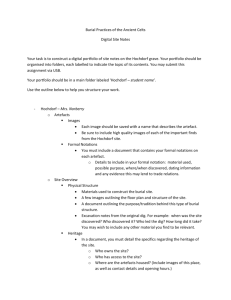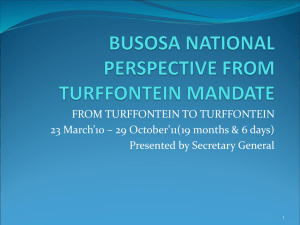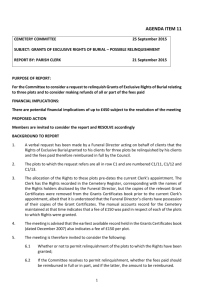Open - The Scottish Government
advertisement
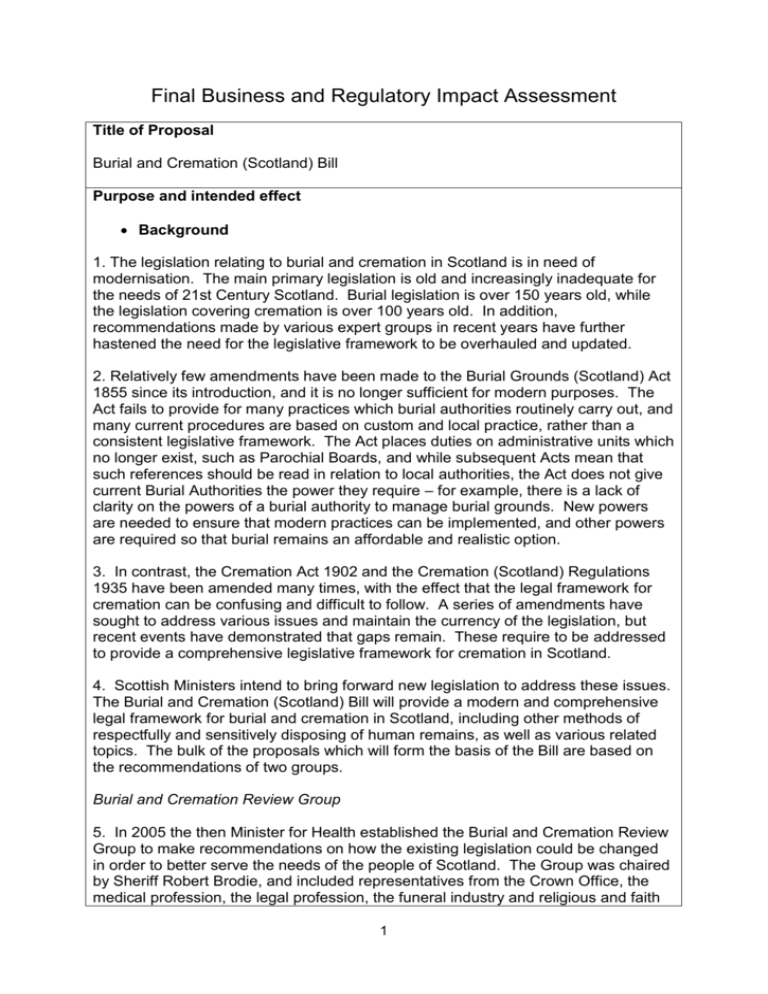
Final Business and Regulatory Impact Assessment Title of Proposal Burial and Cremation (Scotland) Bill Purpose and intended effect Background 1. The legislation relating to burial and cremation in Scotland is in need of modernisation. The main primary legislation is old and increasingly inadequate for the needs of 21st Century Scotland. Burial legislation is over 150 years old, while the legislation covering cremation is over 100 years old. In addition, recommendations made by various expert groups in recent years have further hastened the need for the legislative framework to be overhauled and updated. 2. Relatively few amendments have been made to the Burial Grounds (Scotland) Act 1855 since its introduction, and it is no longer sufficient for modern purposes. The Act fails to provide for many practices which burial authorities routinely carry out, and many current procedures are based on custom and local practice, rather than a consistent legislative framework. The Act places duties on administrative units which no longer exist, such as Parochial Boards, and while subsequent Acts mean that such references should be read in relation to local authorities, the Act does not give current Burial Authorities the power they require – for example, there is a lack of clarity on the powers of a burial authority to manage burial grounds. New powers are needed to ensure that modern practices can be implemented, and other powers are required so that burial remains an affordable and realistic option. 3. In contrast, the Cremation Act 1902 and the Cremation (Scotland) Regulations 1935 have been amended many times, with the effect that the legal framework for cremation can be confusing and difficult to follow. A series of amendments have sought to address various issues and maintain the currency of the legislation, but recent events have demonstrated that gaps remain. These require to be addressed to provide a comprehensive legislative framework for cremation in Scotland. 4. Scottish Ministers intend to bring forward new legislation to address these issues. The Burial and Cremation (Scotland) Bill will provide a modern and comprehensive legal framework for burial and cremation in Scotland, including other methods of respectfully and sensitively disposing of human remains, as well as various related topics. The bulk of the proposals which will form the basis of the Bill are based on the recommendations of two groups. Burial and Cremation Review Group 5. In 2005 the then Minister for Health established the Burial and Cremation Review Group to make recommendations on how the existing legislation could be changed in order to better serve the needs of the people of Scotland. The Group was chaired by Sheriff Robert Brodie, and included representatives from the Crown Office, the medical profession, the legal profession, the funeral industry and religious and faith 1 groups, among others. The Group issued a report in October 2007, which contained 33 recommendations. 6. Many of the recommendations concerned improvements to the certification of death in Scotland, and these were implemented by the Certification of Death (Scotland) Act 2011. Other recommendations relating to burial and cremation were not implemented at that time, and the intention is to give effect to them in this Bill. Infant Cremation Commission 7. The other recommendations considered in the consultation paper are those made by the Infant Cremation Commission. In response to concerns about previous practices in the cremation of infants, in April 2013 the Minister for Public Health announced the creation of an independent Commission to examine the policies, practice and legislation relating to the cremation of infants in Scotland. The Commission was chaired by the Rt Hon Lord Bonomy and considered a range of issues. It published its report in June 2014, making 64 recommendations, all of which were accepted by the Scottish Government. Those which require legislative effect will be implemented in this Bill. Other policies considered 8. A number of other issues have arisen separately from these reports, including funeral costs and the regulation of funeral directors. These issues have been considered as the Bill has been developed. Objective 9. The Bill will provide a modern legislative framework for burial and cremation. This will ensure a robust and comprehensive process is set out in legislation to meet the diverse needs of modern Scotland, and will provide for both current and future demand. The Bill will remove some of the existing uncertainty around particular processes, their extent and the action that can be taken by certain stakeholders. Existing processes will be improved, ensuring that procedures are carried out safely and consistently, with a clear record of what has been done and why. Rationale for Government intervention 10. The Bill does not fit neatly into the National Performance Framework, but it does touch on various objectives. It makes a contribution to the Wealthier and Fairer objective, insofar as it will improve particular processes for businesses and create nationally consistent procedures. The Bill also makes a contribution to the Greener objective, particularly in supporting the long-term sustainability of burial grounds, as well as green burial and other more environmentally friendly methods of disposing of human remains. 2 Consultation Within Government 11. Scottish Government officials from various directorates have been involved in the development of policy. In some cases this has been on an ongoing basis, while for others it has involved specific engagement on a particular issue. Various other agencies have also been involved in policy development. Scottish Government Planning and Architecture Division: ongoing engagement about the minimum distance between crematoriums and other buildings; consideration of compulsory purchase orders Social Security Policy and Delivery Division: ongoing engagement about funeral costs Equality, Human Rights and Third Sector Division: ongoing engagement about funeral costs Culture and Historic Environment Division: engagement about the interaction between the Bill and the historic environment, particularly burial grounds Public Health Division: ongoing engagement about death certification policy Criminal Justice Division: ongoing engagement about licensing policy; ongoing engagement about offences Marine Planning and Policy: engagement about burial at sea Other government agencies Historic Scotland: engagement about the interaction between the Bill and Historic Scotland’s responsibilities Crown Office and Procurator Fiscal Service (COPFS): ongoing engagement about offences National Records of Scotland: engagement about records created by the Bill Registers of Scotland: engagement about registration of burials in places other than recognised burial grounds Public Consultation 12. A full public consultation was carried out between January and April 2015. The Scottish Government published an analysis report of submissions to the consultation, which sets out how people answered each question. The report indicates the Scottish Government has responded to the consultation, including how policy proposals were amended as a result. The analysis report can be viewed at http://www.gov.scot/Publications/2015/07/9665. Business 13. In addition to the business who responded to the public consultation, the Scottish Government has engaged with various businesses to consider the Bill’s potential effect. This has been done in various ways, including working groups, face3 to-face meetings, telephone calls and email exchange. This engagement has been an ongoing process during the development of the Bill. Federation of Burial and Cremation Authorities (FBCA) Institute of Crematorium and Cemetery Management (ICCM) National Association of Funeral Directors (NAFD) National Society of Allied and Independent Funeral Directors (SAIF) Porteous Family Funeral Directors (as part of engagement with SAIF) William Jordan & Son (Funeral Directors) Limited (as part of engagement with SAIF) Ironside Funeral Services (as part of engagement with SAIF) Brodies Funeral Services Ltd (as part of engagement with SAIF) Thomas Cuthell & Sons (as part of engagement with NAFD) Co-operative Funeralcare (as part of engagement with NAFD) Scotmid Co-Operative Funeral Directors (as part of engagement with NAFD) Edinburgh Crematorium Ltd Dignity Funerals Ltd Commonwealth War Graves Commission City of London Cemetery and Crematorium 14. Given the Bill’s expected impact on local authorities, the Scottish Government has carried out extensive consultation with representatives of Scotland’s local authorities. This includes working groups, face-to-face meetings, telephone calls and email exchanges. Aberdeen City Aberdeenshire Angus Argyll and Bute City of Edinburgh Clackmannanshire Dumfries and Galloway Dundee City East Ayrshire East Dunbartonshire East Lothian East Renfrewshire Falkirk Fife Glasgow City Highland Inverclyde Midlothian Moray Na h-Eileanan Siar North Ayrshire North Lanarkshire Orkney Islands 4 Perth and Kinross Renfrewshire Scottish Borders Shetland Islands South Ayrshire South Lanarkshire Stirling West Dunbartonshire West Lothian Association of Local Government Archaeological Officers (ALGAO) Scottish Bereavement Benchmarking Group (SBBG) Policy Options 15. Table 1 sets out a list of those sectors and groups likely to be affected by the Bill, along with expected costs and benefits. Scottish Firms Impact Test 16. The Scottish Government has held ongoing discussions with various businesses which will be affected by the Bill. These are listed at paragraph 13. Engagement with these businesses had a number of purposes: to sense-check policy proposals; to inform policy development; and to consider the potential impact of the Bill. The Bill is expected to affect particular groups in specific ways; accordingly, the Scottish Government has engaged with these businesses by sector. 17. The impact of the Bill on businesses will generally be relatively minor. Most of the Bill’s proposals improve existing processes, often by replacing the current process with a more modern and consistent process. These are likely to have relatively few implications for business. There are, however, several parts of the Bill which are expected to have a more significant impact on particular sectors, especially the reuse of burial lairs and the possible introduction of an inspection and licensing regime for funeral directors. Funeral directors 18. Most of the Bill is unlikely to have any particular impact on funeral directors; meetings with the NAFD and SAIF indicated that they are relatively content with the extent of the Bill and its expected implications for the sector. Discussions with funeral directors have particularly informed the development of proposals for an inspection regime and the possibility of the introduction of a licensing scheme. 19. The proposal that is most likely to affect funeral directors is the potential introduction of an inspection regime and a licensing fee. Both the NAFD and SAIF are supportive in principle of inspection and licensing, and recognise the benefits this will bring for funeral directors and their customers. However, both organisations already have their own inspection regimes, and if the Bill introduces a national inspection regime, consideration will need to be given to how this will fit alongside 5 those organisations’ existing inspection. A balance will need to be struck between ensuring that an inspection regime provides consistency across Scotland and imposing unnecessary additional demands on funeral directors. The intention is that any inspection or licensing regime will be introduced with a long lead-in period, which will allow for further detailed discussion with the sector to develop a scheme that is proportionate and provides the necessary benefits. The Financial Memorandum for the Bill discusses the potential cost implications of introducing a licensing scheme. While there are various possible models, the Scottish Government currently favours one that sets a sliding scale of fees based on the size and scale of a funeral director’s business – this is similar to how the membership fee structure for the NAFD and SAIF operates. These options will be considered with funeral directors if Ministers choose to introduce a licensing scheme. Burial authorities 20. Burial authorities (both private and public) will be affected by the Bill. Discussions with burial authorities have suggested that the majority are content with the broad approach being taken in the Bill. In particular, the Scottish Government was keen to explore the potential financial impact of burial ground management regulations. The consensus was that such regulations will be helpful, but will not necessarily require burial authorities to carry out activity not already undertaken. The overall cost implications are therefore expected to be relatively minimal for the majority of burial authorities. 21. Engagement with burial authorities was particularly helpful in shaping the final policy on the reuse of burial lairs, and has informed various associated policies which will be in the final Bill. Additionally, burial authorities have also informed the estimated costs associated with the processes set out in the Bill for the reuse of lairs. Estimates have varied widely, but the majority have settled within the range of £30,000 to £60,000 – this is based on the current costs of the process for the City of London Cemetery (the only burial authority in the UK that can currently reuse graves) and forecasts based on each burial authority’s cost estimates. The Scottish Government intends to continue to work with burial authorities to refine estimates. Cremation authorities 22. The Bill will have relatively few implications for cremation authorities, mainly because those elements which affect them will be delivered through improvements to existing processes rather than additional processes. The key policy that has been informed through engagement with cremation authorities is the revision of the cremation application form. Discussion with cremation authorities has suggested that this is welcomed, will improve current processes and remove many of the inconsistencies and uncertainties which exist currently. Other sectors 23. Most of the Bill’s impact will be on burial authorities, cremation authorities and funeral directors, but some other sectors will also be affected. The Scottish Government has engaged directly with such businesses and organisation. Discussion with the Commonwealth War Graves Commission (CWGC) on the issue 6 of burial lair reuse has helped to shape the policy to ensure that the CWGC is able to influence proposals to reuse particular lairs at an early stage. 24. Engagement with the Association of Local Government Archaeological Officers has helped to shape the final policy proposals on the reuse of burial lairs. Competition Assessment 25. The impact of each of the main policy options has been considered. Conclusions are based on extensive engagement with stakeholders, as well as the broader context in which policy has been developed. Reuse of burial lairs The proposal will not directly limit the number or range of suppliers; the proposals are not mandatory. Additionally, local authorities will have a duty to provide at least one open burial ground, and that will not be affected by the reuse of burial lairs. The proposal will not indirectly limit the number or range of suppliers. There are no expected indirect implications of the proposal. The proposal will not limit the ability of suppliers to compete. While the initial cost of the lair reuse process is relatively high (estimated at £30,000 – £60,000 per 200 lairs), it is likely to generate sufficient revenue to cover costs and produce a profit of between £30,000 – £100,000. As such, it is not expected to limit suppliers’ ability to compete. These costs are discussed fully in the Financial Memorandum. Estimates are based on the current processes used by the City of London Cemetery and Crematorium, as well as discussion with burial authorities in Scotland. The proposal will not reduce suppliers' incentives to compete vigorously. Regulations for the management of burial grounds The proposal will not directly limit the number or range of suppliers. The proposal will have no impact on the number or range of suppliers. The proposal will not indirectly limit the number or range of suppliers. The proposal will not limit the ability of suppliers to compete. The proposal will not reduce suppliers' incentives to compete vigorously. Appointment of inspectors The proposal is unlikely to limit the number or range of suppliers. Any business which is unable to meet the prescribed inspection standards will either need to improve to an acceptable standard or cease to operate. Standards are expected to be set at a similar level to those which exists currently; as such, the imposition of new standards is not expected to be onerous to the point that suppliers are unable to meet them. The proposal will not indirectly limit the number or range of suppliers. The proposal will not limit the ability of suppliers to compete. The proposal will not reduce suppliers' incentives to compete vigorously. 7 Introduction of licensing for funeral directors The proposal is unlikely to limit the number or range of suppliers. Any business which is unable to meet required standards for the granting of a licence will either need to improve to an acceptable standard or cease to operate. Standards are expected to be set at a similar level to those which exists currently; as such, the imposition of new standards is not expected to be onerous to the point that suppliers are unable to meet them. Similarly, the licence fee will be set at such a level as to avoid a negative impact on suppliers. The proposal will not indirectly limit the number or range of suppliers. The proposal will not limit the ability of suppliers to compete. Indeed, the granting of licences is likely to drive up standards and improve a supplier’s ability to compete. The proposal will not reduce suppliers' incentives to compete vigorously. The standards that will need to be met to be granted a licence should increase the need for vigorous competition. The legislation dealing with licensing schemes is the Civic Government (Scotland) Act 1982. A comparable scheme is the one in place for premises that carry out skin piercing and tattooing. The legislation gives Local Authorities the power to license individuals who carry out skin piercing or tattooing activities as a business. The amount of the licence fee is set by the local authority and the amounts can vary considerably. For example a three year licence issued by Edinburgh City Council is £500 whereas a licence for the same period issued by Borders Council is £172. The intent of the 1982 Act is that any licence fees should be set at a cost recovery amount, to be met by the applicant. Local authorities have the power to set a licence fee at a higher level depending on local issues or to discourage particular activities – for example, licence fees for sex shops are often set at prohibitive levels to discourage their operation. This is unlikely to be an issue for funeral directors, and any licence fees are expected to be set on a sliding scale to reflect the size of each particular business. Addressing funeral costs The proposal will not directly limit the number or range of suppliers. No restrictions are being placed on suppliers. The proposal will not indirectly limit the number or range of suppliers. The proposal will not limit the ability of suppliers to compete. The proposal will not reduce suppliers' incentives to compete vigorously. Indeed, if the Bill requires funeral directors to publish their costs, it is likely to drive greater competition. Test run of business forms 26. It is intended to introduce various new forms through regulations. As the forms will be prescribed by regulations, they will be subject to formal consultation in due course. Nonetheless, the Scottish Government is already working with stakeholders to develop new draft forms, which will be considered through formal consultation. 8 Legal Aid Impact Test 27. It is not expected that the Bill will have any particular implications for legal aid. Consultation with the Scottish Legal Aid Board has informed some of the considerations in the BRIA, particularly the impact set out in Table 1. Enforcement, sanctions and monitoring 28. The Bill proposes the creation of various inspector functions, covering the distinct areas of burial, cremation and funeral directors. Inspectors would be responsible for monitoring and enforcing compliance with the legislation, and for imposing any necessary sanctions. This concept has been welcomed by stakeholders (indeed, there is currently an Inspector of Crematoria in post). The intention is that these inspectors will be used to develop and share best practice across Scotland, but will also have responsibilities for ensuring compliance with the legislation and to investigate complaints. 29. It is intended that inspectors will have various powers of enforcement, and will ultimately have the power to suspend the operation of crematoriums and burial grounds in extremely serious circumstances. This is not a power that is expected to be used frequently and the Bill will require several stages of action before any such action can be taken. This kind of enforcement would always be preceded by opportunities for the cremation authority or burial authority to achieve compliance. 30. Similarly, the Bill will contain a power for Scottish Ministers to introduce a licensing scheme for funeral directors which will contain the power for the licenses to be suspended, revoked or refused. 31. The Scottish Government recognises that the potential implications of the actions described above may be severe. However, the current situation, where there are no particular sanctions that can be taken in response to poor practice, is not tenable. Similar approaches are taken elsewhere – other businesses require licences to operate, and those licenses can be withdrawn or revoked where standards are below what is required. Such action would be taken only where absolutely necessary to protect the public, and in most cases would be the end point of a process where the business was given opportunities to improve. 32. While the detail of such schemes and sanctions will be set out in regulations (which will be developed in conjunction with relevant stakeholders), cremation authorities, burial authorities and funeral directors are broadly supportive in principle of these proposals. The Scottish Government has discussed these proposals with stakeholders, who recognise the benefits to the public, including improving public confidence in the funeral industry generally. Implementation and delivery plan 33. The Bill is expected to receive Royal Assent by the end of the 2015–16 Scottish Parliament session. Some parts of the legislation are expected to be commenced almost immediately, but different parts of the Bill will be commenced over a period of 1–2 years; several key policies will be delivered through secondary legislation, and 9 this timescale will allow for the development of regulations. 34. A key element which needs to be implemented as soon as possible is the introduction of new burial and cremation application forms, and it is likely that this will be the focus of the initial development of secondary legislation, which will in turn prescribe the form and content of various forms. 35. The introduction of a licensing scheme for funeral directors is intended to be based on recommendations made by inspectors of funeral directors. It is likely that inspectors will be introduced no earlier than 1 year after the Bill’s comes into force, with recommendations made 1 to 2 years after inspection begins. The development of the licensing scheme is likely to take 1 to 2 years thereafter. Accordingly, it is likely that if a licensing scheme for funeral directors is introduced, it will not be until 2019 at the earliest. Post-implementation review 37. Other than reviewing the funeral directing industry to consider whether further regulation is required in the form of a licensing scheme, no particular review is expected. As such, it will take place within 10 years of the legislation coming into force. Summary and recommendation 38. Table 1 sets out the various options considered, including the costs and benefits associated with each option. The chosen option in each case is noted. 10 Declaration and publication I have read the Business and Regulatory Impact Assessment and I am satisfied that (a) it represents a fair and reasonable view of the expected costs, benefits and impact of the policy, and (b) that the benefits justify the costs. I am satisfied that business impact has been assessed with the support of businesses in Scotland. Signed: Date: 7 October 2015 Maureen Watt Minister for Public Health Scottish Government Contact point: Dr Simon Cuthbert-Kerr, Public Health Division (0131 244 2522; simon.cuthbert-kerr@gov.scot) 11 Table 1: Policy options Policy The right to instruct the disposal of human remains The management of burial grounds Option Do nothing/minimum. Costs Lack of clarity around who has right to instruct the disposal; can lead to family disputes, delays to disposal and legal costs to resolve dispute. Set out who has the legal right to instruct the disposal of human remains. This is the option set out in the Bill. Do nothing/minimum. None, other than the potential for very minor procedural changes. Benefits The status quo remains, meaning that no new procedures will be required; however, this approach would lead to the perpetuation of the existing situation where there is no clear legal position on who has the right to instruct the disposal of human remains. Addresses issue of lack of clarity; provides clear hierarchy for all categories of disposal. General lack of clarity about Costs remain at status quo. what action a burial authority can take to manage burial grounds, particularly when maintaining headstones; uncertainty over what powers a burial authority has in particular circumstances; limited power for burial authorities to take action to address unsafe or abandoned cemeteries, graves and headstones and other memorials; continued safety risks. 12 Give Burial Authorities further support on this matter through guidance. Reuse of burial lairs Limited legal clarity – little improvement on existing position. Set out clear powers and duties in regulations. This is the option set out in the Bill. Potential for increased costs through duties to maintain burial grounds, rather than current power to maintain them. Do nothing/minimum. Current situation persists, where burial grounds fall into disuse and disrepair; cost of burial continues to increase; availability of burial space decreases; reduced opportunities for people to choose burial as an option. Much potential burial space remains unusable. Cost of process to reclaim these lairs; less efficient process, since only some potential lairs are identified; full lairs where there is no active interest remain unused. Reuse process is long and costly; potential opposition from individuals or particular groups; potential for individuals Allow purchased but unused lairs to be sold again by the burial authority after a set period. Allow burial authorities to reuse lairs. This is the option set out in the Bill. 13 Some improved clarity about responsibilities; leaves much discretion to burial authorities and does not place them under duties. Provides strong and unambiguous legal framework; will provide legal basis for activity that most burial authorities carry out already; will ensure that burial grounds are well-maintained and safe. Avoids the costs of reusing lairs; avoids potential for someone to lose burial rights. Allows unused lairs to be reused in certain circumstances; avoids need to disturb human remains. Brings particular lairs back into use, expanding burial capacity, supporting sustainability of burial grounds and making Exhumation Do nothing/minimum. Allow inspectors to make decisions about exhumation. This is the option set out in the Bill. to lose rights to lair even when they have an active interest. burial a more affordable option for more people; improves appearance and safety of older burial grounds where there is no or little current maintenance; cost savings in comparison with extending current burial grounds or creating new burial grounds; generates revenue above costs of reuse process; contributes to a strategic approach to heritage management and burial land capacity. No requirement for burial authorities to use this procedure if they do not want to; no requirement for them to reuse full lairs – they may choose to resell only lairs which are unused. Continued legal costs to people who wish to apply for an exhumation; lack of clarity about the process that is required. Cost to Scottish Government to appoint inspectors; faster and cheaper process may lead to greater number of applications. Status quo remains. 14 Bill establishes clear legal process; more affordable process because applicants no longer need to apply to a sheriff; faster, more Suspension of burial and cremation regulations in event of public health risk Do nothing/minimum. Allow all regulations to be suspended. This is the option set out in the Bill. Revised cremation application form Do nothing/minimum. Risk of lengthy delays as system struggles to cope with increased numbers of deaths; increased public health risk. Need to establish Scottish Parliament process to suspend regulations; potential for increased emissions due to higher numbers of cremations while regulations are suspended; higher risk (although still very low overall) of deaths not being processed properly. Missed opportunity to improve process - existing forms are not fit-for-purpose; continued risk of cremations being carried out wrongly because of inadequacies of the current form; continued lack of clarity over what should happen to ashes. 15 streamlined process; burial authority remains the gatekeeper of the process, so can continue to advise potential applicants on the feasibility of exhuming a particular burial lair. Status quo remains, although there are no particular benefits to this. Supports the system during time of increased deaths; clear parliamentary process for the suspension of regulations, so avoids potential for it to be done without appropriate scrutiny; reduces public health risk; ensures that delays to burial and cremation are kept low. Status quo remains – potential minor savings because new procedures are not introduced. Statutory burial form Cremation Register Revise cremation forms so that there is a single form with separate sections for each category of cremation. This is the option that will be set out in legislation. Form is larger – potentially more complex to complete, particularly if wrong section is completed; increased cost of producing a larger form. Revise cremation forms to create a single form for each category. Potential for increased costs each time a single form is used; increased costs of producing separate forms for each category; potential for incorrect forms to be completed. Do nothing/minimum. Continued lack of consistency across Scotland. Prescribe statutory form. This is the option set out in the Bill. Cost of producing new form; potential to add to bureaucracy since each burial authority currently uses its own form but will have to replace those with a standard form. Do nothing/minimum Limited number of people are able to view register. 16 Clear separation between categories; some questions will apply to particular categories so can be asked at relevant points only rather than being repeated for all categories; all categories of cremation captured by statutory form. Allows increased safeguards by having particular questions (eg, what should be done with ashes) for every category of cremation; all categories of cremation captured by statutory form. Reduced risk of wrong section being completed. Status quo is maintained; every burial authority is able to ask the questions they want to ask. Provides single form so improves consistency; no ambiguity about process; potential for minor administrative savings as every burial authority will use the same form rather than being able to amend its own forms. Status quo is maintained; cremation authorities are under Allow cremation register to be public document. This is the option set out in the Bill. Inspectors Do nothing/minimum Introduce new powers for inspectors of burial. This is the option set out in the Bill. Introduce new powers for inspectors of funeral directors. This is the option set out in no requirement to allow people to view the register – no additional costs through having to enable public access. Costs to cremation authorities Enables more people to view of needing to provide access to the record, bringing it into line the register; potentially limited with other similar records (eg, value to widening access – birth register, death register). register may provide few research opportunities. Missed opportunity – no Status quo remains – avoids independent inspection of additional bureaucracy and burial authorities or funeral costs associated with directors; missed opportunity introducing new inspector to improve public confidence in roles. funeral industry. Missed opportunity to provide further information about particular sectors. Increased costs to Scottish Introduces independent Government of appointing scrutiny of burial authorities; inspectors; increased supports compliance with administrative costs to service legislation; supports best inspectors; increased practice. bureaucracy for burial authorities; need to agree interface between new inspection and existing inspection regimes. Increased costs to Scottish Introduces independent Government of appointing scrutiny of funeral directors; inspectors; increased allows action to be taken in 17 the Bill. Regulation of funeral directors No nothing/minimum. Provide power for Ministers to introduce regulation scheme. This is the option set out in the Bill. Funeral costs Do nothing/minimum. Require local authorities to charge at cost-recovery levels. administrative costs to service inspectors; increased bureaucracy for funeral directors; need to agree interface between new inspection and existing inspection regimes. Opportunity cost – lose opportunity to bring greater regulation of funeral directors. response to poor performance; may support a reduction in funeral costs; may support an improvement in service received. Status quo remains – funeral directors do not have to meet additional costs associated with regulation. No additional costs to Scottish Government of introducing and administering the scheme. Cost to Scottish Government Introduces greater regulation to administer scheme; cost to of funeral directors; allows funeral directors of licence fee greater action to be taken in and any other associated response to poor performance; costs. enables funeral directors who do not meet standards to be kept out of the industry. Supports public confidence in funeral industry. Funeral costs may continue to The funeral industry is left to rise. set its own prices without any intervention from central government. Potential increase in costs – Would offer assurances to many local authorities currently public that prices are not charge at below cost-recovery based on profit; would provide basis. more clarity about funeral costs. 18 Require local authorities to Local authorities would charge a standard national fee. potentially lose income, since costs are not standard across the country; local authorities have a reduced ability to set fees based on their own costs and internal financial arrangements. Require local authorities to Minor administrative costs of publish their costs in full. publishing costs. Require funeral directors to publish their costs in full Would reduce the perception of a ‘postcode lottery’. Would increase transparency of costs, supporting public confidence in the funeral industry. Could lead to price fixing as Would increase transparency funeral directors agree to of costs; would help customers establish equivalent prices; risk to understand all cost elements that sensitive financial of funeral; would potentially information is required to be lower prices overall as funeral shared with competitors; directors were more aware of potential for cheapest funeral other companies’ prices. directors to be considered the best – may emphasise cost over quality of service. 19

